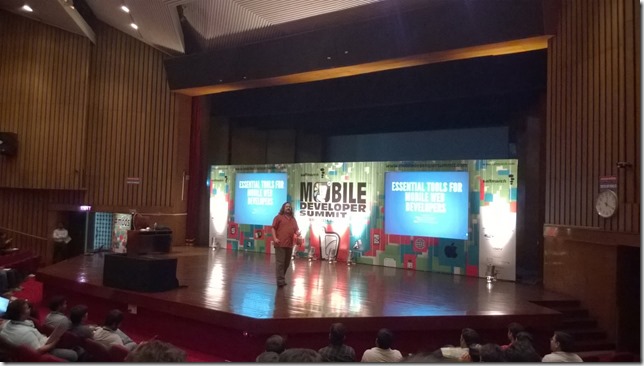This post is about my experiences and the learning I have got from attending my first ever Mobile developer summit (MODS), organised by Saltmarch at J.N.Tata Auditorium, IISC campus, Bangalore. This year’s summit spanned across two days (Oct 9-10,2014). I had just finished the sessions from day 1 and sharing the same here. Each and every session could very well be covered in a separate post, but I am just briefing here on everything in a single post
Keynotes:
After a smooth registration process by 8:30AM in the morning, we were waiting for the keynote to be started by 9:00AM. The first keynote session was given by Scott Davis on “Mobile Web State of the union”. He briefly touched upon the various mobile operating systems like iOS8, Android, Windows Phone 8.1, Firefox OS, Tizen and explained about what different platforms aim at and how each of them is good in their own way. He had also demonstrated about quite a few exciting and interesting iOS applications like Reflector, Hue, Solar city and few other augmented reality based applications. Next was the keynote session on “”Make everything smart” by Narendra Bhandari. He gave an overview on how Intel is working on Internet Of Things and provided good use cases for the same. Followed by this was the keynote by David Huang on “Connecting cars with smartphone apps using smart device link”. David talked about how Ford made use of smart device link and came with their version named Ford Applink. It was amazing to realise how auto industry are coming up with standards on smartphone application ecosystem to seamlessly connect the device and the vehicles.
Essential tools for mobile web developers by Scott Davis:

In this session, Scott talked about various open source tools that could be very handy for the mobile web devs. His focus was primarily for developers using HTML/JS/CSS for mobile. He walked us through with tools that could help in testing the application in different screen sizes viz., Resize my browser, Chrome extension – Window resizer, and also the inbuilt Emulator in Chrome that have a preset device screens and resolutions which one could readily click and test without taking the pain of resizing the browser. Similarly Responsive web design view in Mozilla Firefox is another helpful tool to test the responsive web design. For remote debugging the mobile applications running in the device, Safari Web inspector does a wonderful job for iOS devices. Similarly chrome has a direct support for Android devices. Both devices should have the remote debugging enabled in them, to be able to debug from the browsers. One another tool which I was completely unaware of and got to know from Scott was weinre. It was as simple as dynamically injecting a js file into the html file to be tested. I am yet to explore more on this and looking forward to write a separate post on this in future.
Building an Open source Continuous Delivery Platform for mobile applications by Rishi Ahuja:

This session focused on addressing the challenges that a developer/release team member faces in manually following the process of mobile application delivery. Continuous test and delivery platform for mobile could be used to promote smooth & timely delivery, to maximize productivity and also to improve profitability. This could be achieved by making use of Open source Continuous Integration server Jenkins. Jenkins can be used to specify the orchestration of the various activities that should be performed before deploying a mobile application into app store. i.e., Automated static code analysis, Automated builds, Automated testing, app analytics, code signing & provisioning (for iOS applications). There are rich open source tools and frameworks that are available to perform each of these pieces of automation. Also, there are a lot of plug-in available for Jenkins which eases the process of continuous delivery and making it one of the best continuous integration servers.
Async programming with Javascript by Venkat Subramaniam :
Venkat’s session would always be packed with demos. That’s the best part and I love to attend such sessions. He would not only talk about a concept but also write code along and explain it. That helps the developers understand it much easier. He explained and demoed about various ways of Asynchronous programming with javascript i.e., by using async attribute in script tag, using XHR, using callbacks. How to write unit testable javascript code, and also how to test async javascript methods were some of the notable highlights and take away for me from this session. He emphasised the importance of REPL using node.js. It indeed would be easier and a better approach to try out and test the javascript snippets using node repl before plugging the code into the actual application. There are a lot of new things I learned, as I didn’t have much of prior Javascript experience.
jQuery Mobile by Venkat Subramaniam :
Having already bowled over by his previous demo based presentation 🙂 , I continued with Venkat on his next topic on jQuery mobile. He started with making use of Chrome browser console to try out jQuery snippets before actually using them in the real code. Then, we had in-detail discussion on the data-* attributes of html 5 and how jquery mobile makes effective use of those, all with live demos.
All in all, I felt I got a good opportunity to learn about quite a good amount of new technologies, toolsets and the best practices around mobile development. Looking forward to participate in more of such events and keep the learning curve going on and on 🙂